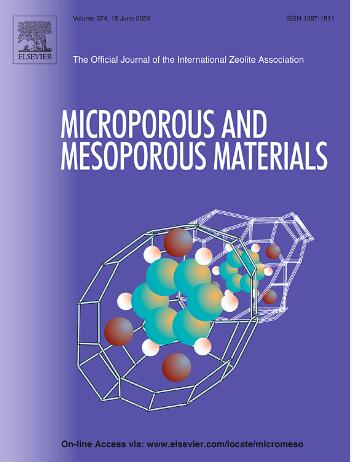Role of silanol groups and hydrothermal rehydroxylation on the functionalization of SBA-15 with APTES for CO2 capture
IF 4.8
3区 材料科学
Q1 CHEMISTRY, APPLIED
引用次数: 0
Abstract
To identify the most suitable initial characteristics of an APTES-functionalized SBA-15 material, a series of SBA-15 samples was synthesized. Firstly, to remove the template, two methods were employed: i) water and ethanol washing method, and ii) calcination method where three calcination temperatures were explored (350, 450 and 550 °C), all carried out in a constant air flow. The purpose of avoiding calcination of the material is to prevent the loss of silanol groups, which play a key role in the chemical modification with amino groups. And secondly, a portion of these materials were subjected to a hydrothermal process to improve the amount of surface silanol groups, groups on which APTES molecules are anchored. As a result, eight materials were obtained and subsequently functionalized with APTES. Based on the nitrogen adsorption isotherms, an increase in pore size was observed when the material is rehydroxylated, which demonstrates the formation of silanol groups. Upon functionalization, the average pore size decreased by approximately 1.0 nm, suggesting the formation of new bonds between the surface silanol groups with the ethoxy groups of the APTES molecule. The CO2 uptake capacity showed promising results for most of the materials, with the uncalcined materials presenting the highest values, 2.52 and 2.32 mmol g−1 at 1 bar and 25 °C for S15WC-F and S15WC-FR, respectively.

硅烷醇基团和水热再羟基化对SBA-15 APTES官能化CO2捕集的作用
为了确定aptes功能化SBA-15材料最合适的初始特性,我们合成了一系列SBA-15样品。首先,采用两种方法去除模板:1)水和乙醇洗涤法;2)煅烧法,在恒定气流中分别探索了三种煅烧温度(350、450和550℃)。避免材料煅烧的目的是为了防止硅醇基的损失,硅醇基在氨基化学修饰中起着关键作用。其次,这些材料的一部分进行了水热处理,以提高表面硅醇基团的数量,这些基团是APTES分子锚定的基团。结果,获得了8种材料,并随后用APTES进行了功能化。根据氮吸附等温线,当材料被再羟基化时,观察到孔径的增加,这表明硅醇基的形成。功能化后,APTES分子的平均孔径减小了约1.0 nm,表明APTES分子表面硅醇基与乙氧基之间形成了新的键。大多数材料的CO2吸收能力都很好,其中S15WC-F和S15WC-FR在1 bar和25℃条件下,未煅烧材料的CO2吸收能力最高,分别为2.52和2.32 mmol g−1。
本文章由计算机程序翻译,如有差异,请以英文原文为准。
求助全文
约1分钟内获得全文
求助全文
来源期刊

Microporous and Mesoporous Materials
化学-材料科学:综合
CiteScore
10.70
自引率
5.80%
发文量
649
审稿时长
26 days
期刊介绍:
Microporous and Mesoporous Materials covers novel and significant aspects of porous solids classified as either microporous (pore size up to 2 nm) or mesoporous (pore size 2 to 50 nm). The porosity should have a specific impact on the material properties or application. Typical examples are zeolites and zeolite-like materials, pillared materials, clathrasils and clathrates, carbon molecular sieves, ordered mesoporous materials, organic/inorganic porous hybrid materials, or porous metal oxides. Both natural and synthetic porous materials are within the scope of the journal.
Topics which are particularly of interest include:
All aspects of natural microporous and mesoporous solids
The synthesis of crystalline or amorphous porous materials
The physico-chemical characterization of microporous and mesoporous solids, especially spectroscopic and microscopic
The modification of microporous and mesoporous solids, for example by ion exchange or solid-state reactions
All topics related to diffusion of mobile species in the pores of microporous and mesoporous materials
Adsorption (and other separation techniques) using microporous or mesoporous adsorbents
Catalysis by microporous and mesoporous materials
Host/guest interactions
Theoretical chemistry and modelling of host/guest interactions
All topics related to the application of microporous and mesoporous materials in industrial catalysis, separation technology, environmental protection, electrochemistry, membranes, sensors, optical devices, etc.
 求助内容:
求助内容: 应助结果提醒方式:
应助结果提醒方式:


